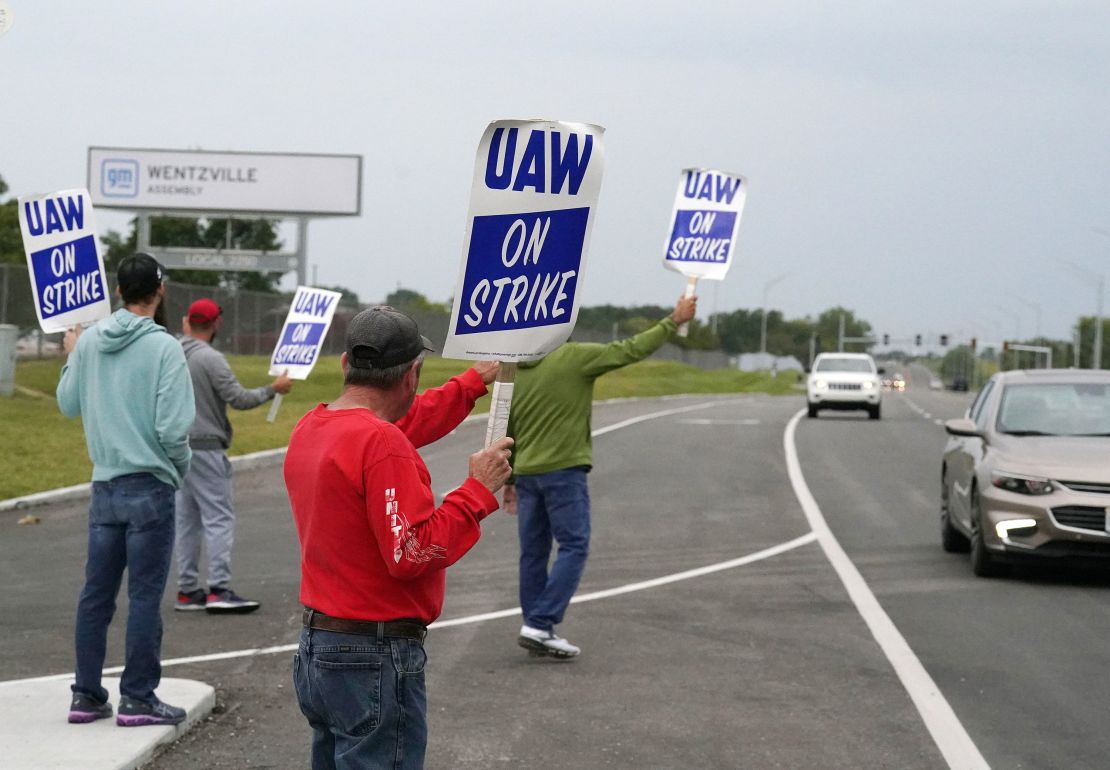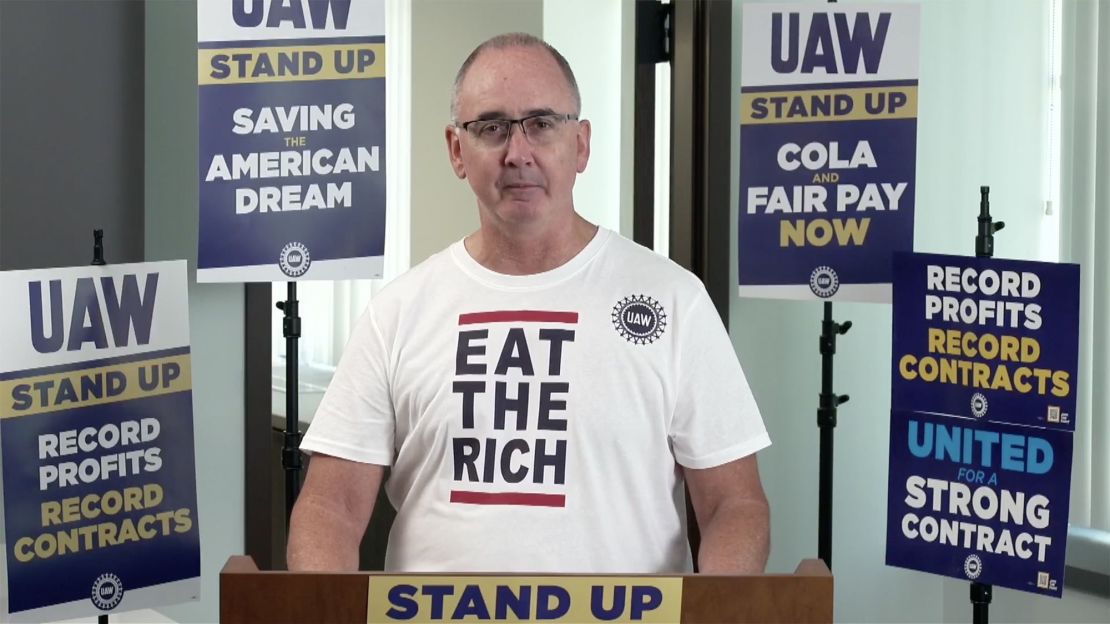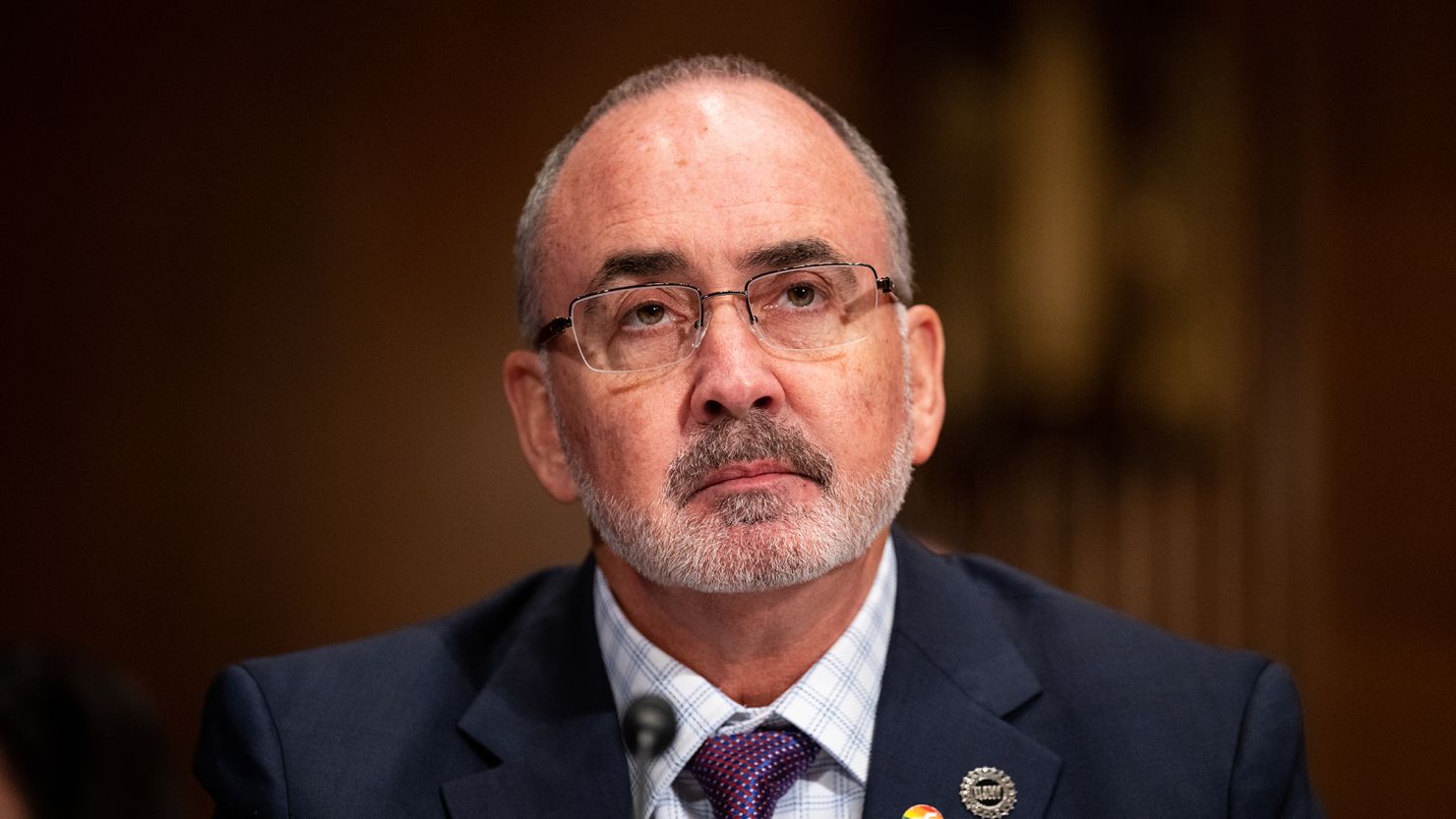The longest US auto strike this century is over after a pretty clear win for the United Auto Workers union at all three unionized automakers. But don’t think the union is moving to repair relations between labor and management the way it has after past strikes.
The union and the automakers typically talked a good game about cooperation when there isn’t a strike going on.
“I don’t like what I’ve seen in my work career with the UAW leadership, where they were too damn close to the companies,” UAW President Shawn Fain told CNN earlier this month.
But when asked if things work better for his members when there’s a less contentious or more contentious relationship between the UAW and the Big Three, Fain responded, “We just negotiated the most successful contracts in our history,” he said. “For the last 30 years that I’ve been a member, we went backwards. So I like to let the body of work speak for itself.”
The success of those contracts is the reason that Shawn Fain is CNN Business’ labor leader of the year.
CNN Business has been naming a “CEO of the year” for many years now, but this year’s success of unions winning significant wage increases, often by waging high-profile strikes, pointed to the need for a labor leader of the year as well.
And for a change, we saw numerous candidates from which to choose.
It could have been Teamsters union President Sean O’Brien, who won a record contract at UPS without actually having to take more than 340,000 members there on strike.
It could have been Fran Drescher, the president of SAG-AFTRA, who led her union of 160,000 actors on 118-day strike that, together with a strike by 11,000 members of the Writers Guild of America, resulted in both improved wages and protections from the use of artificial intelligence, an issue of growing importance for a broad range of workers.
It could have been a much lower profile union leader, such at Ted Pappageorge, secretary-treasurer and chief negotiator for the Culinary workers union in Las Vegas who negotiated deals for 35,000 workers at 18 casinos along the Las Vegas Strip.
Or maybe the leaders of a coalition of unions at Kaiser Permanente, where a three-day strike that was the largest work stoppage in US history resulted in significant pay and staffing improvements that members were seeking.
All told nearly 800,000 union members got raises of 10% or more during 2023. But in many ways the most significant are the contracts negotiated by Fain for the 145,000 members at General Motors, Ford and Stellantis.
Double-digit raises, and more
The deal included immediate raises of at least 11%, plus an additional 14 percentage point of raises during the life of a contract that runs through April of 2028.
It included the return of cost-of-living adjustments, which together with the guaranteed raises, are likely to raise wages by more than 30% during the contract.
It included the end of lower-paid wage tiers and the conversion of lower-paid temporary workers to permanent employees, changes that will raise some wages between 80% to 150%. It got a closed factory at Stellantis reopened and the right to strike again to protest future plant closings.

“I thought it was a grand slam,” said Art Wheaton, director of labor studies at Cornell University’s School of Industrial and Labor Relations. “They got massive increases for newer workers. For the existing workforce it was extremely good, better than I would have imagined.”
But perhaps the biggest win for the union was winning the chance to eventually have these contracts cover workers who will be building batteries for electric vehicles, or EVs, at plants now under construction.
All the automakers have announced plans to shift from traditional gas-powered cars to EVs in coming years, a change that could bring an end to tens of thousands of union jobs building engines and transmissions.
The dozen EV battery plants planned by the three unionized automakers are to be owned and run by joint ventures, so the employees would not necessarily have been UAW members. And even if they did vote to join the union, most expected they would be paid a fraction of what UAW members at the automakers get paid..
Many experts think this was the most significant win for the union in a contract full of union wins.
“I think that was the piece I didn’t expect,” said Jeff Schuster, global head of automotive for GlobalData, an industry consultant. “It was tough to see that happening heading into negotiations. It’s a big win for them.”
Missing on a few targets
Despite the contracts’ gains, some within the union’s rank-and-file objected. Nearly a third of members at Ford and Stellantis voted not to ratify the deals, and 45% of members at GM voted no.
The union missed on a few goals such as a return of retiree health care coverage and a traditional pension plan for workers hired since 2007. Fain even floated the idea of getting a four-day, 32-hour work week without any drop in pay, an idea he said he still intends to pursue in the future.
Fain said he doesn’t see the no votes during the ratification vote as a criticism of him or union leadership.

“I’m proud of the results,” he said. “I think it’s a testament to the companies that they better understand that workers have high expectations, and they’re tired of watching companies make billions and billions in profits and at the expense of their lives.”
To the criticism of the deals, and in some cases of him, expressed in comments during his Facebook Live remarks to members, he was straightforward.
“Look, I agree with some of it,” he said. “We were trying to undo decades of going backwards in one agreement. That was a massive, massive challenge. You know, we achieved things in his contract that people said would never happen.”
Organizing nonunion automakers
Fain has perhaps set an even more ambitious goal in the coming year, as he launched an attempt to organize workers at the US plants of foreign automakers, as well as nonunion EV makers such as Tesla and Rivian.
It’s an effort the union tried before, but always failed. But with more than half of US autos now made at nonunion plants, and with UAW membership down by 300,000, or 45% since the start of the century, it’s crucial to the union’s continued success, perhaps even its survival.
Many of the other automakers are responding to the union’s negotiating success, and its organizing efforts, by announcing pay increases of their own, what Fain is referring to as the “UAW bump.”
He said those pay raises won’t hurt the union’s efforts to organize, and that it’s the workers at those nonunion plants, not the union, driving the organizing efforts.
“This is a movement from the [nonunion] workers, not the UAW,” he said.
Elected by narrow margin
Fain was elected in May in the first popular election the union had ever held for its leadership. Only union officers could vote to pick UAW presidents in the past.
But a scandal that sent two former presidents to prison for misusing union funds, plus other union and company officials going to prison for bribery, resulted in the union agreeing to a consent decree with the Justice Department that brought the first union vote.
Even with a popular election now held, Fain admits he was an underdog when he entered the race just over a year ago. He was a union official and staffer from a Chrysler plant in Kokomo, Indiana, who had never been elected to a national office at the union.
“Look at everything that was against us in that race against me in that race. I mean, you’re taking on an establishment of power that has been in place longer than I’ve been alive,” he said. “I believed that our membership was ready for change. That’s why I ran. I believed the majority of our membership, just like myself, was frustrated.
“But me running for this, it was it was honestly an act of faith,” he said. “The fact that no one really literally knew who I was other than Chrysler people. It wasn’t like I was well known throughout the country with our membership.”
He survived the first round of voting, placing him in a runoff with Ray Curry, the incumbent president who had taken office in the wake of the scandal.
In May, he won a vote by just more than 500 votes. And he had to hit the ground running to prepare for negotiations with contracts with all three automakers set to expired at 12:01 am ET on September 15.
He immediately made it clear this would be a different kind of negotiation.
The talks between the companies and the union always previously started with the union president and the CEO of each company posing for a photo shaking hands across the negotiating table.
Fain refused to do so.
An unprecedented strategy
More importantly, the union had always picked one of the three automakers as a “target” of negotiations, seeking a deal, perhaps via a strike, while granting an extension and staying on the job at the other two automakers.
Once a deal was reached, it would try to get the other two automakers to agree with the pattern set at the negotiating target.
But Fain and the union’s leadership kept telling the automakers and the media that it wasn’t going to do that this time, that it was prepared to strike all three at the same time for the first time in its history.
Not many believed he would follow through with that threat. He did.
Having a strike by all 145,000 members at the same time would drain the union’s $825 million strike fund that paid out $500 a week in benefits to strikers, in roughly three months.
But Fain and the union decided on a different strategy, a targeted strike that began with one assembly plant at each company, and only 12,700 members being on strike.
Then, as negotiations dragged on, he expanded the strike six different times as a way of increasing pressure on the automakers. Eventually about 60,000 members were on strike at one point or another.
The unprecedented strategy is what resulted in the negotiating victory according to experts who followed the strike.
“I think what was surprising, the unpredictability and tactics that he chose,” said GlobalData’s Schuster. “The approach was very unconventional and he did very well for the UAW in terms of what they did get.”

Fain’s rhetoric was particularly harsh during the strike. He appeared on one of his Facebook Live talks announcing an expansion of the strike wearing an “Eat the Rich” T-shirt.
He was accused of waging class warfare, and of making demands that would bankrupt companies.
But soon after the deals, General Motors announced it had enough money to spend $10 billion in repurchasing shares of its stock to benefit its investors. The other automakers said they would remain profitable.
Fain said he’s fine with the companies’ success, as long as his members get their fair share.
“We want companies to succeed,” he said. “You know, our members take pride in the companies they work for, they take pride in the product they build. But we’re not going to be the sacrificial lambs and have everything be done on their backs anymore. [Having the companies] rake in billions in profits and just keep enriching themselves, those days are over.”








